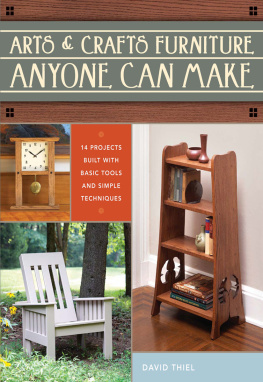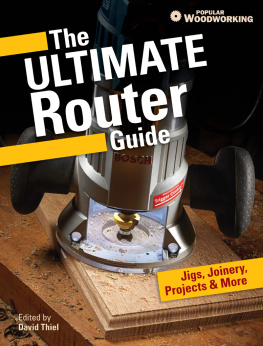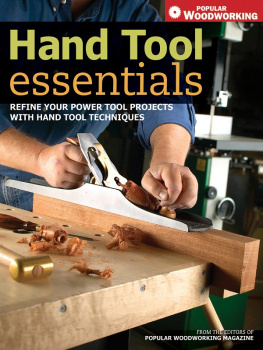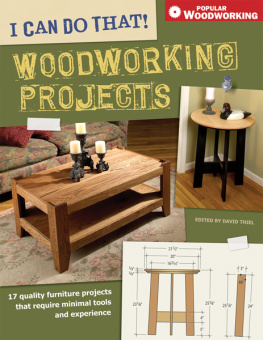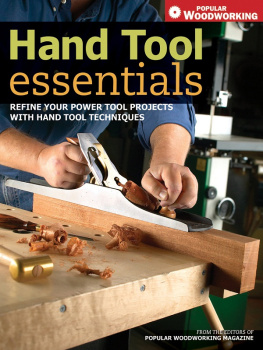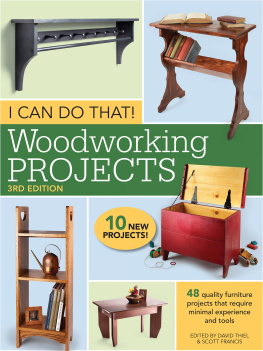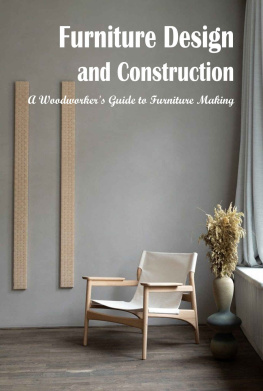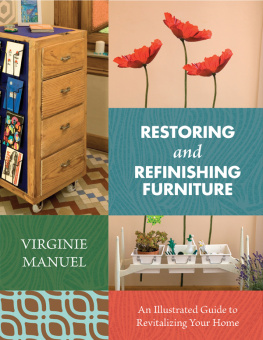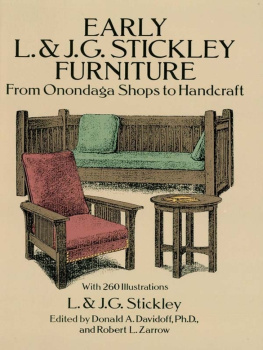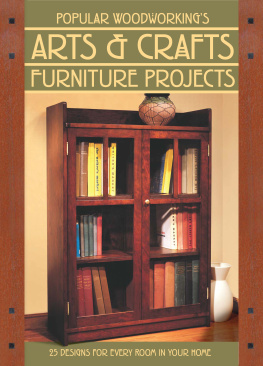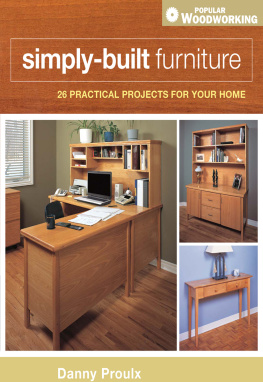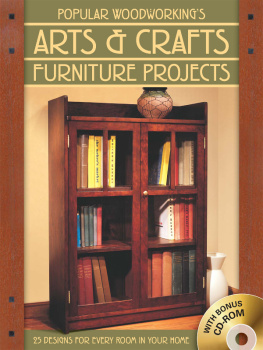ARTS & CRAFTS FURNITURE ANYONE CAN MAKE
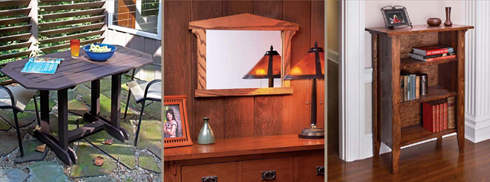
DAVID THIEL

ARTS & CRAFTS FURNITURE ANYONE CAN MAKE. Copyright 2010 by David Thiel. Printed and bound in China. All rights reserved. No part of this book may be reproduced in any form or by any electronic or mechanical means including information storage and retrieval systems without permission in writing from the publisher, except by a reviewer, who may quote brief passages in a review. Published by Popular Woodworking Books, an imprint of F+W Media, Inc., 4700 East Galbraith Road, Cincinnati, Ohio, 45236. (800) 289-0963 First edition.
Distributed in Canada by Fraser Direct
100 Armstrong Avenue
Georgetown, Ontario L7G 5S4
Canada
Distributed in the U.K and Europe by F+W Media International
Brunel House
Newton Abbot
Devon TQ12 4PU
England
Tel: (+44) 1626 323200
Fax: (+44) 1626 323319
E-mail: postmaster@davidandcharles.co.uk
Distributed in Australia by Capricorn Link
P.O. Box 704
Windsor, NSW 2756
Australia
Visit our Web site at www.popularwoodworking.com.

Other fine Popular Woodworking Books are available from your local bookstore or direct from the publisher.
14 13 12 11 10 5 4 3 2 1
Library of Congress Cataloging-in-Publication Data
Thiel, David, 1962
Arts & crafts furniture anyne can make / by David Thiel 1st ed.
p. cm.
ISBN 978-1-4403-0673-0 (pbk : alk. paper)
eISBN 13: 978-1-4403-1401-8
1. Furniture making Amateurs' manuals. 2. Woodwork Amateurs' manuals. I. Title. II. Title: Arts and crafts anyone can make
TT195.T55 2010
684.08 dc22
2010034810
SENIOR EDITOR: Jim Stack
DESIGNER: Brian Roeth
PRODUCTION COORDINATOR: Mark Griffin
PHOTOGRAPHER: David Thiel, Al Parrish (project openers)
ILLUSTRATOR: Jim Stack
METRIC CONVERSION CHART
TO CONVERT | TO | MULTIPLY BY |
Inches | Centimeters | 2.54 |
Centimeters | Inches | 0.4 |
Feet | Centimeters | 30.5 |
Centimeters | Feet | 0.03 |
Yards | Meters | 0.9 |
Meters | Yards | 1.1 |
READ THIS IMPORTANT SAFETY NOTICE
To prevent accidents, keep safety in mind while you work. Use the safety guards installed on power equipment; they are for your protection.
When working on power equipment, keep fingers away from saw blades, wear safety goggles to prevent injuries from flying wood chips and sawdust, wear hearing protection and consider installing a dust vacuum to reduce the amount of airborne sawdust in your woodshop.
Don't wear loose clothing, such as neckties or shirts with loose sleeves, or jewelry, such as rings, necklaces or bracelets, when working on power equipment. Tie back long hair to prevent it from getting caught in your equipment.
People who are sensitive to certain chemicals should check the chemical content of any product before using it.
Due to the variability of local conditions, construction materials, skill levels, etc., neither the author nor Popular Woodworking Books assumes any responsibility for any accidents, injuries, damages or other losses incurred resulting from the material presented in this book.
The authors and editors who compiled this book have tried to make the contents as accurate and correct as possible. Plans, illustrations, photographs and text have been carefully checked. All instructions, plans and projects should be carefully read, studied and understood before beginning construction.
Prices listed for supplies and equipment were current at the time of publication and are subject to change.
ABOUT THE AUTHOR
David started woodworking at an early age by using the drill press in his father's woodworking buisness to drill holes in blocks of scrap wood on Saturdays. He eventually started actually building recognizable items as he worked with and for his father through high school and college.
A degree in English Literature shifted his sights to journalism, but he was never far away from woodworking, eventually opening his own custom woodworking shop for a few years.
In the mid-90's he found a blending of both worlds, going to work for Popular Woodworking magazine as an editor, builder and tool reviewer.
He took on a side job as host of the DIY Network's Tools & Techniques (still playing somewhere out in space), and in the beginning of the new millenia he started working at his current position as Executive Editor with Popular Woodworking Books.
David lives in Cincinnati, Ohio and still enjoys checking out a new tool, whenever possible. You can visit his web site at www.theshopofthecrafters.com.
ACKNOWLEDGEMENTS
As an author, whenever I refer to my book I always feel uncomfortable. While it certainly is my book, there are always others who deserve recognition for its creation.
First is to my family. My wife, Patti and all five kids, Dillon, Danielle, Shannon, Ben and Zach, who put up with my disappearing into the garage to build something. There were too many weekends lost to the book that could have been family time.
I'll again thank Patti, first for her love then for her design direction and input on all the projects. Even if it was just a comforting that looks great (and there were many more in-depth discussions), her support through the project was extremely important; so I dedicate this book to her. Thank you, babe.
Thanks to Jim Stack, my editor, who I've known for over thirty years, in a few different roles. His patience and quiet support (and excellent illustration work) kept me from chewing my nails too far.
And to my designer Brian Roeth, again for patience and for allowing me to gently nudge the design, even though he knew where he was going.
Thanks also to my e-mail critic, Jeff Korbman, for his instightful read of the nearlyfinished manuscript.
A big thank you to Steve and Kit for letting us use the house of many rooms as background for the opening photos.
And lastly, to my readers over the years, both with Popular Woodworking Magazine, and in earlier books. Your feedback, both positive and corrective gave me the recognition of the need for a book that offered time- and material-consious woodworking projects that still looked good. I hope this book serves as a thank you.
INTRODUCTION
It was 1995 when I first started appreciating Arts & Crafts furniture for its simple lines and honest strength. One of the foremost pieces in this style was the Morris chair (in a dizzying array of designs from known and unknown designers). These chairs held features that I appreciated. Strong, comfortable (for reading or relaxing), ample seat area for one-and-a-half people and generally not all that complicated in design but for the mortise-and-tenon construction.
So I built a couple. They lived up to my expectations, looked good and made me proud. Then fall entered my little part of southwest Ohio and I wanted to spend more time on my deck enjoying the crisp air and the beautiful colors (along with a good cigar and a nice glass of wine). And I wanted to be comfortable like in my Morris chair. While white oak is actually a pretty sturdy outdoor wood, I wasn't in the mood to drag (let alone leave) my Morris chair outside. What to do?

